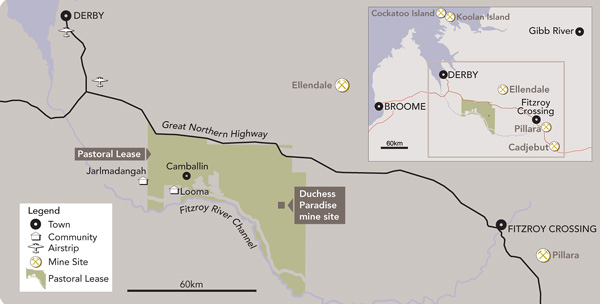Lately I’ve been asking myself, what is it about my beautiful ancestral homeland, the Kimberley, that makes it the target of choice for unwanted and destructive resource projects?
Why can’t politicians and corporate leaders work with my community and other communities across the Kimberley to develop sustainable businesses that will conserve our unique landscapes, wildlife and culture?
As an academic, Broome Shire Councillor, traditional custodian within the Nyikina Mangala native title group, Peter Cullen Water Leadership Fellow and engaged community member, I am deeply concerned about the current proposal for the first coal mine in the Kimberley, the Duchess Paradise Project.
The underground coal mine is to be located on a remote pastoral station, almost 200km south east of Derby, in a region of the Kimberley — the Fitzroy Valley — renowned for its diversity and beauty. It’s also to be situated just kilometres from the banks of the mighty Fitzroy River, or as it is known to my people — Mardoowarra, meaning "living water".

The Mardoowarra is the lifeblood of the Kimberley, sustaining one of the last great wilderness areas left on the planet. Mardoowarra flows from the hill country past the Great Sandy Desert, through the tropical savannah to the saltwater mangroves on the coast. The entire river was added to the Australian National Heritage list in 2011, and the site ear-marked for mining is home to 35 wildlife species of conservation priority, such as the critically endangered Biyal Biyal (giant freshwater sawfish).
Public submissions closed on April 22. The EPA will complete its assessment of this initial coal mining proposal from Rey Resources Ltd, prior to WA Environment Minister Albert Jacob making his final decision on whether or not to approve it. I encourage people who care about this globally significant region — and our future — to make their voices heard.
I like to ensure that every decision I make is based on the most up-to-date, independent and well-researched information. However, in reading the environmental assessment, I believe there is inadequate baseline data to make assumptions about impacts of the mine, and a lack of evidence to substantiate claims.
The limited information in the assessment is scary enough — especially the admission that around 140 road trains, each capable of carrying 100 tonnes of coal, will pass through the small town of Derby every day.
This will have a huge impact on the health, safety and quality of life of Derby residents and Fitzroy valley communities. Surface and ground water impacts, coal dust and acid mine drainage are all significant concerns, especially as the region is prone to massive flooding from the monsoonal storms and cyclones each wet season.
I am also deeply concerned about the damage to the Kimberley’s internationally recognised and very valuable "brand". There has been no assessment of the loss of opportunities for sustainable businesses caused by the inherent conflict between large scale coal mining and coal transport, and tourism-related economic activity throughout the Fitzroy valley.
There are already many Indigenous tourism and cultural businesses operating in the Fitzroy valley, with little or no government support. What will become of these local initiatives in the face of massive coal trucks and all the other tangible and intangible impacts of coal mining?
Until we have enough information to truly make informed decisions, I have no confidence that traditional custodians and communities affected by this proposal will be able to truly determine what the direct and indirect impacts will be on their way of life.
The current native title process assists companies to put pressure on native title groups to support mining without being fully informed of the potential risk scenarios. I am concerned by the fact that Traditional Owners cannot veto a mine on their country — this effectively means their agreement is a foregone conclusion, even when the science demonstrates it will destroy their land, water, plants and animals.
There have been recent precedents set in WA, where the EPA and the WA state government have made decisions to protect our communities and environment in iconic areas.
Three such precents are: dis-allowing coal mining in Margaret River for social reasons; ruling out copper mining from Horizontal Falls due to its tourism status; and most recently introducing special protection legislation aimed at preserving the special character of Perth’s Swan Valley wine region.
We really need an overarching mechanism to protect the natural and cultural values of the Fitzroy River and to ensure that any proposed development in the catchment is rigorously assessed against community-generated sustainability criteria.
It is imperative that we set a new, clear, economically and environmentally sustainable, community-driven course for this amazing river system.
In the meantime, my plea is to Minister Jacob: Please don’t let my land, my river and our culture and heritage be destroyed.
Donate To New Matilda
New Matilda is a small, independent media outlet. We survive through reader contributions, and never losing a lawsuit. If you got something from this article, giving something back helps us to continue speaking truth to power. Every little bit counts.



